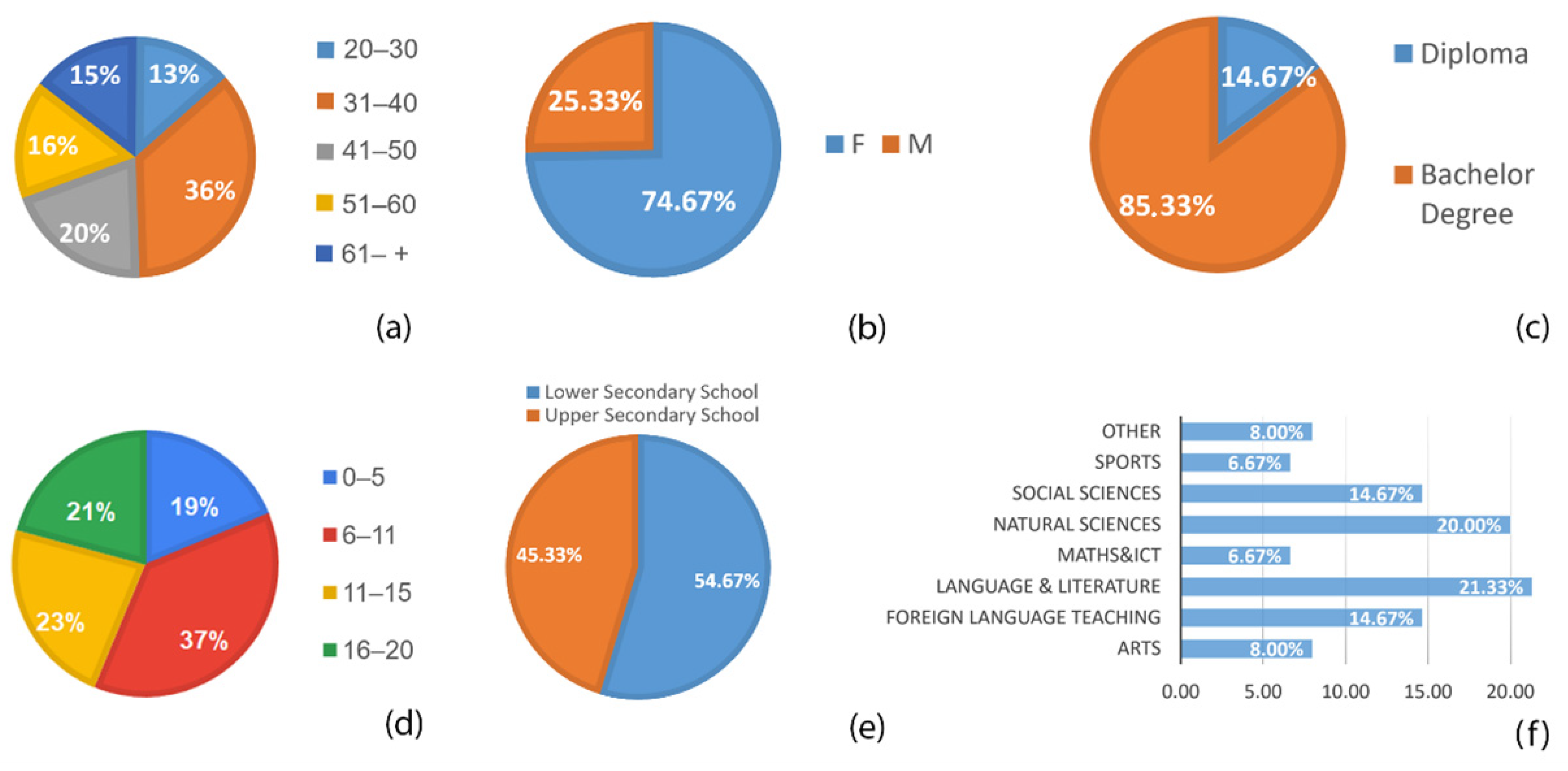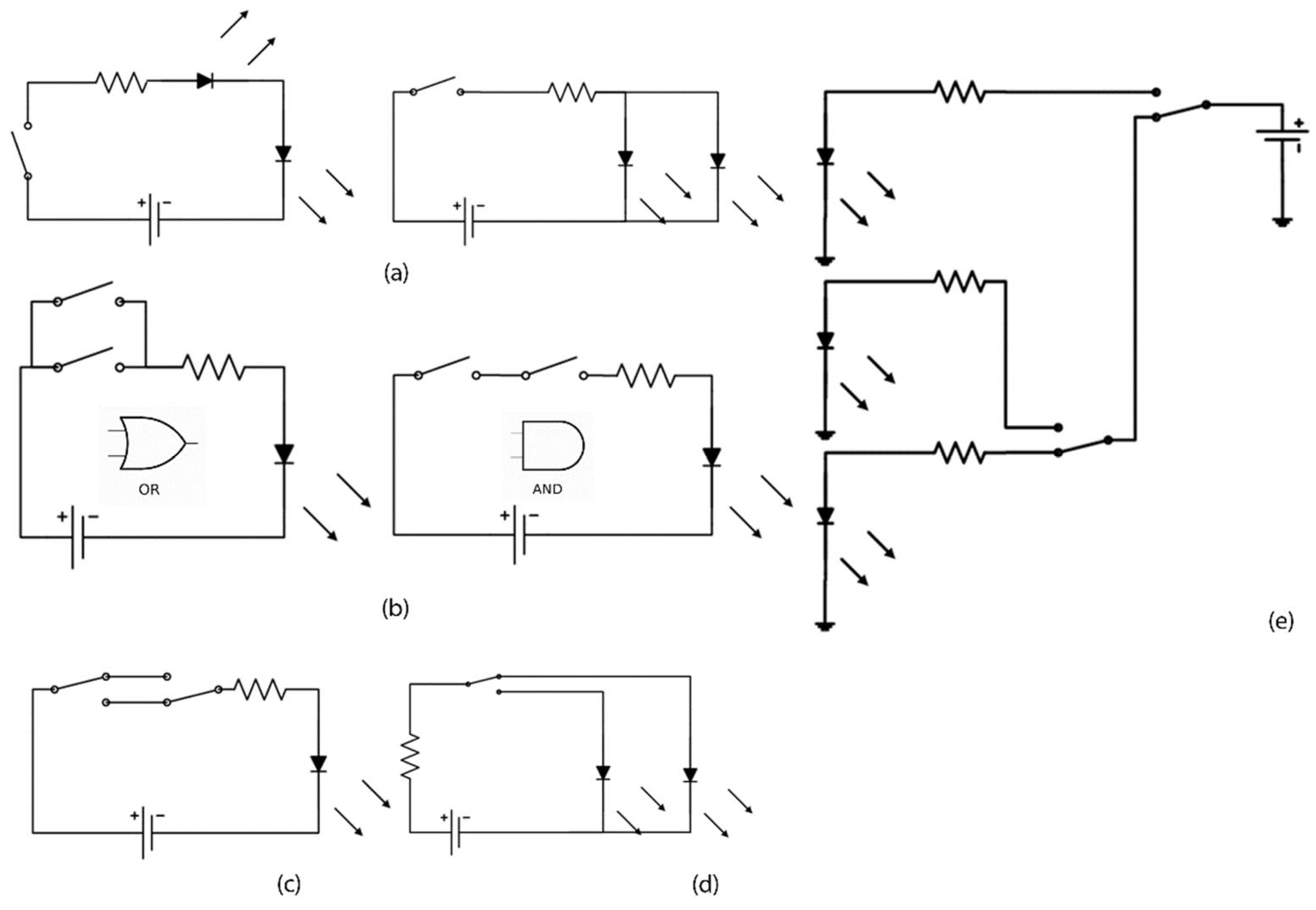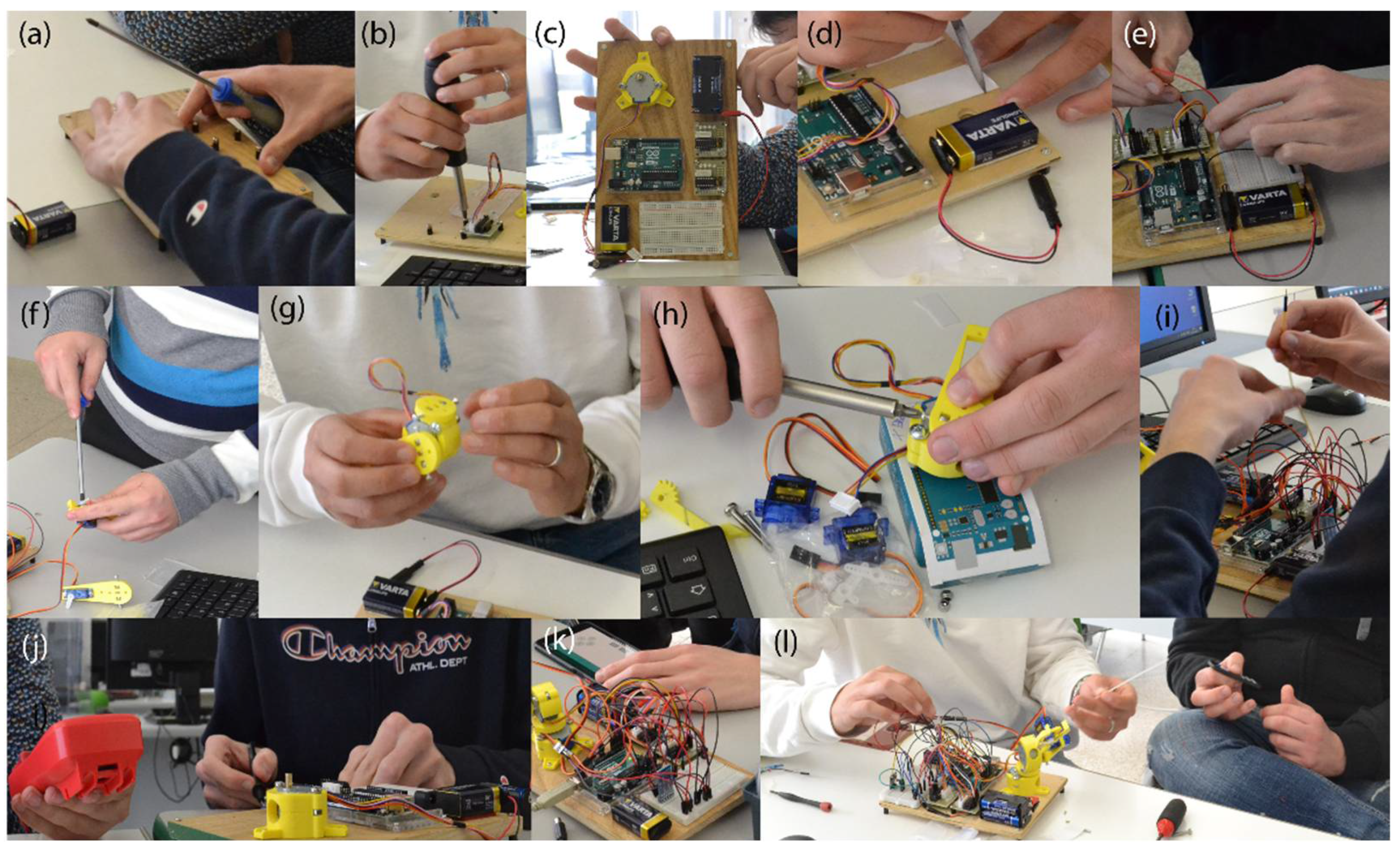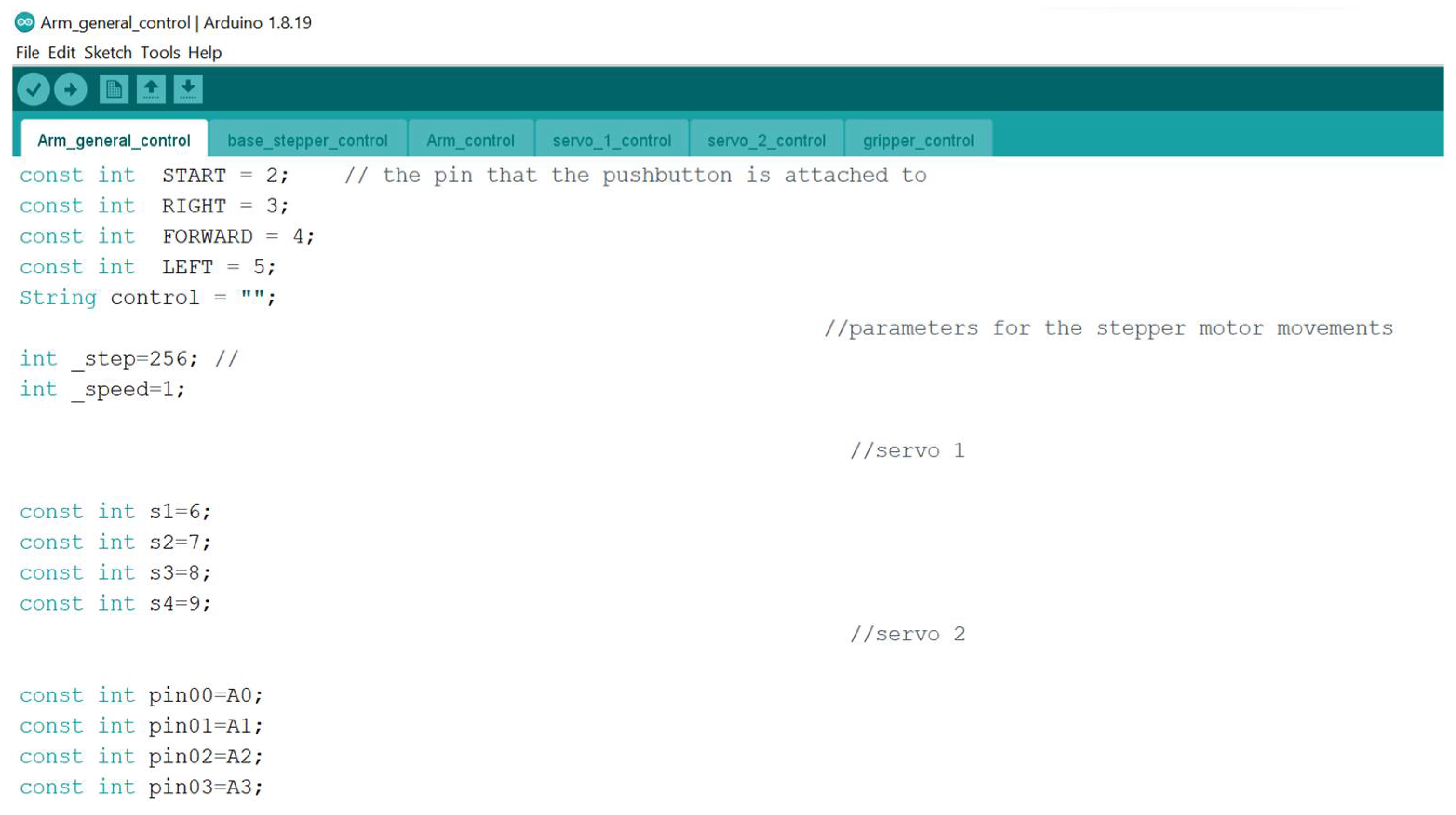Design Thinking as an Auxiliary Tool for Educational Robotics Classes
Abstract
:1. Introduction
2. Teachers’ Profile and Their Perception of DT Aspects That Are Lacking in Current Curricula
3. Design Thinking within the Context of ER Classes: The Methodological Framework
3.1. The Introduction of the Design Thinking Methodology
3.2. The Prototyping and Testing Phases
- Electronics fundamentals with Arduino coding;
- Robotic arm 3D design.
- A short (10–15 min) theoretical introduction aiming to reveal the physical basis and the principles of a hardware piece studied at the time with live demonstrations or a brief introduction into a new aspect of 3D shape synthesis in Tinkercad;
- Practice with several coding examples to provide initial experience with a new electronic component or work in the Tinkercad platform to strengthen the skills with the new aspect covered;
- The assignments required independent work and problem solutions based on combinations of the concepts covered during the consecutive meetings.
3.3. Work in Tinkercad
3.4. Work with Electronics and Coding
- The distribution and fixing of the hardware pieces on a wooden board;
- Selection of the control principle (Bluetooth, IR, touch sensor);
- Organization of the electrical interconnections;
- Testing of the power supply;
- Uploading of the code;
- Final system testing and debugging in accordance with the chosen control mechanism.
4. Discussion of the Results
5. Conclusions and Future Perspectives
Author Contributions
Funding
Institutional Review Board Statement
Informed Consent Statement
Data Availability Statement
Conflicts of Interest
References
- Eurostat, E. People at Risk of Poverty or Social Exclusion by Age and Sex. Available online: https://ec.europa.eu/eurostat/databrowser/view/ILC_PEPS01/default/table?lang=en (accessed on 13 December 2022).
- Baturina, D.; Berc, G.; Majdak, M. An invisible problem–a real risk: Student drop-out from secondary education. Rev. Soc. Polit. 2014, 21, 43–67. [Google Scholar]
- Novo-Corti, I.; Țîrcă, D.-M.; Ziolo, M.; Picatoste, X. Social Effects of Economic Crisis: Risk of Exclusion. An Overview of the European Context. Sustainability 2019, 11, 336. [Google Scholar] [CrossRef] [Green Version]
- Tsolou, O.; Babalis, T.; Tsoli, K. The Impact of COVID-19 Pandemic on Education: Social Exclusion and Dropping out of School. Creat. Educ. 2021, 12, 529–544. [Google Scholar] [CrossRef]
- Ekstrand, B. What it takes to keep children in school: A research review. Educ. Rev. 2014, 67, 459–482. [Google Scholar] [CrossRef]
- Vinciguerra, A.; Nanty, I.; Guillaumin, C.; Rusch, E.; Cornu, L.; Courtois, R. The determinants of dropping out in secondary education: A literature review. Psychol. Fr. 2021, 66, 15–40. [Google Scholar]
- Latorre-Medina, M.J.; Blanco-Encomienda, F.; Fernández-Maqueira, M. Linking school improvement with a better qualification for teachers. The need for change in the Spanish educational system. In Proceedings of the 5th International Conference on Future of Teaching and Education, Rotterdam, The Netherlands, 25–27 February 2022. [Google Scholar]
- Shafi, M.M.; Neyestani, M.R.; Jafari, S.E.M.; Taghvaei, V. The Quality Improvement Indicators of the Curriculum at the Technical and Vocational Higher Education. Int. J. Instruct. 2021, 14, 65–84. [Google Scholar] [CrossRef]
- Zhao, Y.; Watterston, J. The changes we need: Education post COVID-19. J. Educ. Chang. 2021, 22, 3–12. [Google Scholar] [CrossRef]
- Ansari, B.I.; Taufiq, T.; Saminan, S. The use of creative problem solving model to develop students’ adaptive reasoning ability: Inductive, deductive, and intuitive. Int. J. Teach. Learn. Math. 2020, 3, 23–36. [Google Scholar] [CrossRef]
- Alexander, K.L.; Entwisle, D.; Kabbani, N. The dropout process in life course perspective: Early risk factors at home and school. Teach. Coll. Rec. 2001, 103, 760–822. [Google Scholar] [CrossRef]
- Goldschmidt, P.; Wang, J. When can schools affect dropout behavior? A longitudinal multilevel analysis. Am. Educ. Res. J. 1999, 36, 715–738. [Google Scholar] [CrossRef]
- Rumberger, R.W. Dropping out of middle school: A multilevel analysis of students and schools. Am. Educ. Res. J. 1995, 32, 583–625. [Google Scholar] [CrossRef]
- Matheson, G.O.; Klügl, M.; Engebretsen, L.; Bendiksen, F.; Blair, S.N.; Börjesson, M.; Budgett, R.; Derman, W.; Erdener, U.; Ioannidis, J.P.A.; et al. Prevention and Management of Non-Communicable Disease: The IOC Consensus Statement, Lausanne 2013. Sports Med. 2013, 43, 1075–1088. [Google Scholar] [CrossRef] [PubMed]
- Wang, Y.-P. Effects of Online Problem-Solving Instruction and Identification Attitude Toward Instructional Strategies on Students’ Creativity. Front. Psychol. 2021, 12, 771128. [Google Scholar] [CrossRef]
- Agnew, R.; White, H.R. An Empirical Test of General Strain Theory. Criminology 1992, 30, 475–500. [Google Scholar] [CrossRef]
- Dewi, S.M.; Gunawan, G.; Harjono, A.; Susilawati, S.; Herayanti, L. Generative learning models assisted by virtual laboratory to improve mastery of student physics concept. J. Phys. Conf. Ser. 2020, 1521. [Google Scholar] [CrossRef]
- Colombo, M. Policy Against Drop-out in Italy. Cent. Eur. J. Educ. Res. 2019, 1, 1–9. [Google Scholar] [CrossRef] [Green Version]
- Schargel, F.P.; Smink, J. Strategies to Help Solve Our School Dropout Problem; Routledge: London, UK, 2014. [Google Scholar] [CrossRef]
- Doran, M.V.; Coleman, R.L. Enhanced creativity and problem solving: An interdisciplinary approach. In Proceedings of the 16th World Multi-Conference on Systemics, Cybernetics and Informatics (WMSCI 2012), Orlando, FL, USA, 17–20 July 2012. [Google Scholar]
- Elaby, M.F.; Elwishy, H.M.; Moatamed, S.F.; Abdelwahed, M.A.; Rashiedy, A.E. Does design-build concept improve problem-solving skills? An analysis of first-year engineering students. Ain Shams Eng. J. 2022, 13, 101780. [Google Scholar] [CrossRef]
- Kuo, J.Y.; Song, X.T.; Chen, C.H.; Patel, C.D. Fostering Design Thinking in Transdisciplinary Engineering Education. In Transdisciplinary Engineering for Resilience: Responding to System Disruptions; IOS Press: Amsterdam, The Netherlands, 2021; pp. 63–70. [Google Scholar]
- Ladachart, L.; Radchanet, V.; Phothong, W. Design Thinking Mindsets Facilitating Students’ Learning of Scientific Concepts in Design-Based Activities. J. Turk. Sci. Educ. (TUSED) 2022, 19, 1–16. [Google Scholar]
- Loh, A.P.; Law, E.; Putra, A.S.; Koh, E.; Zuea, T.K.; Tat, K.E. Innovation, Design & Entrepreneurship in Engineering Education. Adv. Eng. Educ. J. 2021. Available online: https://eric.ed.gov/?id=EJ1316313 (accessed on 13 December 2022).
- Solodikhina, A.; Solodikhina, M. Developing an innovator’s thinking in engineering education. Educ. Inf. Technol. 2021, 27, 2569–2584. [Google Scholar] [CrossRef]
- Soomro, S.A.; Casakin, H.; Georgiev, G.V. Sustainable Design and Prototyping Using Digital Fabrication Tools for Education. Sustainability 2021, 13, 1196. [Google Scholar] [CrossRef]
- Tramonti, M.; Dochshanov, A. Game Environment and Design Thinking Approach for New Digital Careers. Digit. Present. Preserv. Cult. Sci. Herit. 2021, 11, 309–314. [Google Scholar] [CrossRef]
- Arnold, J.E.; Clancey, W.J. Creative Engineering: Promoting Innovation by Thinking Differently; Arnold, J.E., Jr., Ed.; Stanford Department of Special Collections and University Archives: Stanford, CA, USA, 2016; Volume 5, p. 2020. [Google Scholar]
- Plattner, H.; Meinel, C.; Leifer, L. Design Thinking: Understand–Improve–Apply; Springer Science & Business Media: New York, NY, USA, 2010. [Google Scholar]
- Luka, I. Design Thinking in Pedagogy. J. Educ. Cult. Soc. 2014, 5, 63–74. [Google Scholar] [CrossRef]
- Brown, T. Design thinking. Harv. Bus. Rev. 2008, 86, 84. [Google Scholar] [PubMed]
- Hendricson, W.D.; Andrieu, S.C.; Chadwick, D.G.; Chmar, J.E.; Cole, J.R.; George, M.C.; Glickman, G.N.; Glover, J.F.; Goldberg, J.S.; Haden, N.K. Educational strategies associated with development of problem-solving, critical thinking, and self-directed learning. J. Dent. Educ. 2006, 70, 925–936. [Google Scholar] [PubMed]
- Martin, R.L. The innovation catalysts. Harv. Bus. Rev. 2011, 89, 82–87. [Google Scholar]
- Davis, M. Making a Case for Design-Based Learning. Arts Educ. Policy Rev. 1998, 100, 7–15. [Google Scholar] [CrossRef] [Green Version]
- Grebin, N.; Grabovska, S.; Karkovska, R.; Vovk, A. Applying Benjamin Bloom’s Taxonomy Ideas in Adult Learning. J. Educ. Cult. Soc. 2020, 11, 61–72. [Google Scholar] [CrossRef]
- Fisher, R. Creative Minds: Building communities of learning for the creative age. 2002. Available online: http://pantaneto.co.uk/creative-minds-building-communities-of-learning-for-the-creative-age-robert-fisher/ (accessed on 13 December 2022).
- Beckman, S.L.; Barry, M. Innovation as a Learning Process: Embedding Design Thinking. Calif. Manag. Rev. 2007, 50, 25–56. [Google Scholar] [CrossRef]
- Yoon, F.S.; Ho, J.; Hedberg, J.G. Teachers as Designers of Learning Environments. Comput. Sch. 2005, 22, 145–157. [Google Scholar] [CrossRef]
- Rauth, I.; Köppen, E.; Jobst, B.; Meinel, C. Design thinking: An educational model towards creative confidence. In Proceedings of the 1st International Conference on Design Creativity (ICDC 2010), Kobe, Japan, 29 November–1 December 2010. [Google Scholar]
- Koh, J.H.L.; Chai, C.S.; Wong, B.; Hong, H.Y. Design Thinking for Education: Conceptions and Applications in Teaching and Learning; Springer: Berlin, Germany, 2015. [Google Scholar]
- Svihla, V.; Reeve, R.; Sagy, O.; Kali, Y. A fingerprint pattern of supports for teachers’ designing of technology-enhanced learning. Instr. Sci. 2015, 43, 283–307. [Google Scholar] [CrossRef]
- Vaughn, M.; Parsons, S.A. Adaptive teachers as innovators: Instructional adaptations opening spaces for enhanced literacy learning. Lang. Arts 2013, 91, 81–93. [Google Scholar]
- Adams, R.S.; Daly, S.R.; Mann, L.M.; Dall’Alba, G. Being a professional: Three lenses into design thinking, acting, and being. Des. Stud. 2011, 32, 588–607. [Google Scholar] [CrossRef] [Green Version]
- Anderson, N.; Adam, R.; Taylor, P.; Madden, D.; Melles, G.; Kuek, C.; Wright, N.; Ewens, B. Design Thinking Frameworks As Transformative Cross-Disciplinary Pedagogy. 2014. Available online: https://researchonline.jcu.edu.au/37592/ (accessed on 6 January 2023).
- León-Mantero, C.; Casas-Rosal, J.C.; Pedrosa-Jesús, C.; Maz-Machado, A. Measuring attitude towards mathematics using Likert scale surveys: The weighted average. PLoS ONE 2020, 15, e0239626. [Google Scholar] [CrossRef] [PubMed]
- Wells, A. The importance of design thinking for technological literacy: A phenomenological perspective. Int. J. Technol. Des. Educ. 2012, 23, 623–636. [Google Scholar] [CrossRef]
- Beitz, W. Design Science—The Need for a Scientific Basis for Engineering Design Methodology. J. Eng. Des. 1994, 5, 129–133. [Google Scholar] [CrossRef]
- Lammi, M.; Becker, K. Engineering Design Thinking. J. Technol. Educ. 2013, 24, 55–77. [Google Scholar]
- Açar, A.E.; Rother, D.S. Design Thinking in Engineering Education and its Adoption in Technology-driven Startups. In Advances in Sustainable Manufacturing; Springer: Berlin, Germany, 2011; pp. 57–62. [Google Scholar] [CrossRef]
- Bartzer, S. The development of creative thinking through an adequate engineering education. In Proceedings of the International Conference on Engineering Education, Oslo, Norway, 6–10 August 2001. [Google Scholar]
- Chevalier, M.; Giang, C.; Piatti, A.; Mondada, F. Fostering computational thinking through educational robotics: A model for creative computational problem solving. Int. J. STEM Educ. 2020, 7, 1–18. [Google Scholar] [CrossRef]
- Noweski, C.; Scheer, A.; Büttner, N.; von Thienen, J.; Erdmann, J.; Meinel, C. Towards a Paradigm Shift in Education Practice: Developing Twenty-First Century Skills with Design Thinking. In Design Thinking Research; Springer: New York, NY, USA, 2012; pp. 71–94. [Google Scholar] [CrossRef]
- Kuo, H.-C.; Yang, Y.-T.C.; Chen, J.-S.; Hou, T.-W.; Ho, M.-T. The Impact of Design Thinking PBL Robot Course on College Students’ Learning Motivation and Creative Thinking. IEEE Trans. Educ. 2021, 65, 124–131. [Google Scholar] [CrossRef]
- Gubenko, A.; Kirsch, C.; Smilek, J.N.; Lubart, T.; Houssemand, C. Educational Robotics and Robot Creativity: An Interdisciplinary Dialogue. Front. Robot. AI 2021, 8, 178. [Google Scholar] [CrossRef]
- Wiggins, G.P. Assessing Student Performance: Exploring the Purpose and Limits of Testing; Jossey-Bass: San Francisco, CA, USA, 1993. [Google Scholar]
- Zawieska, K.; Duffy, B.R. The Social Construction of Creativity in Educational Robotics. In Progress in Automation, Robotics and Measuring Techniques; Springer: Cham, Switzerland, 2015; Volume 351, pp. 329–338. [Google Scholar] [CrossRef]
- Alden, D.; Tramonti, M. Computational Design Thinking and Physical Computing: Preliminary Observations of a Pilot Study. Robotics 2020, 9, 71. [Google Scholar] [CrossRef]
- Buhl, H.R. Creative Engineering Design; Iowa State University Press: Ames, IO, USA, 1960. [Google Scholar]
- Chou, P.-N. Skill Development and Knowledge Acquisition Cultivated by Maker Education: Evidence from Arduino-based Educational Robotics. Eurasia J. Math. Sci. Technol. Educ. 2018, 14, 93483. [Google Scholar] [CrossRef]
- Nelson, C.A. Generating Transferable Skills in STEM through Educational Robotics. In K-12 Education: Concepts, Methodologies, Tools, and Applications; IGI Global: Hershey, PA, USA, 2013; pp. 433–444. [Google Scholar] [CrossRef]
- Owen, C. Design thinking: Notes on its nature and use. Des. Res. Q. 2007, 2, 16–27. [Google Scholar]
- Eris, Ö. Asking generative design questions: A fundamental cognitive mechanism in design thinking. In Proceedings of the 14th International Conference on Engineering Design, Stockholm, Sweden, 19–21 August 2003. [Google Scholar]
- Dorst, K. The core of ‘design thinking’ and its application. Des. Stud. 2011, 32, 521–532. [Google Scholar] [CrossRef]
- Lindberg, T.; Meinel, C.; Wagner, R. Design Thinking: A Fruitful Concept for IT Development? In Design Thinking; Springer: Berlin/Heidelberg, Germany, 2010; pp. 3–18. [Google Scholar] [CrossRef] [Green Version]
- Wu, B.; Hu, Y.; Wang, M. Scaffolding design thinking in online STEM preservice teacher training. Br. J. Educ. Technol. 2019, 50, 2271–2287. [Google Scholar] [CrossRef]
- Lempiälä, T.; Vanharanta, O. Rethinking the Control–Freedom Paradox in Innovation: Toward a Multifaceted Understanding of Creative Freedom. J. Appl. Behav. Sci. 2017, 54, 62–87. [Google Scholar] [CrossRef] [Green Version]
- Liikkanen, L.A.; Perttula, M. Exploring problem decomposition in conceptual design among novice designers. Des. Stud. 2008, 30, 38–59. [Google Scholar] [CrossRef]
- Song, T.; Becker, K.; Gero, J.; Deberard, S.; Lawanto, O.; Reeve, E. Problem Decomposition and Recomposition in Engineering Design: A Comparison of Design Behavior Between Professional Engineers, Engineering Seniors, and Engineering Freshmen. J. Technol. Educ. 2016, 27, 37–56. [Google Scholar] [CrossRef] [Green Version]
- Dosi, C.; Rosati, F.; Vignoli, M. Measuring design thinking mindset. In Proceedings of the DESIGN 2018 15th International Design Conference, Dubrovnik, Croatia, 21–24 May 2018. [Google Scholar]
- Smith, R.C.; Iversen, O.S.; Hjorth, M. Design thinking for digital fabrication in education. Int. J. Child-Comput. Interact. 2015, 5, 20–28. [Google Scholar] [CrossRef]
- Pearson, H.A.; Dubé, A.K. 3D printing as an educational technology: Theoretical perspectives, learning outcomes, and recommendations for practice. Educ. Inf. Technol. 2021, 27, 3037–3064. [Google Scholar] [CrossRef]
- Cook, K.L.; Bush, S.B. Design thinking in integrated STEAM learning: Surveying the landscape and exploring exemplars in elementary grades. Sch. Sci. Math. 2018, 118, 93–103. [Google Scholar] [CrossRef]
- Mahil, S. Fostering STEM+ education: Improve design thinking skills. In Proceedings of the 2016 IEEE Global Engineering Education Conference (EDUCON), Abu Dhabi, United Arab Emirates, 10–13 April 2016. [Google Scholar]
- Banzi, M.; Shiloh, M. Getting Started with Arduino; Maker Media, Inc.: Sebastopol, CA, USA, 2022. [Google Scholar]
- Fixson, S.K.; Rao, J. Learning Emergent Strategies Through Design Thinking. Des. Manag. Rev. 2014, 25, 46–53. [Google Scholar] [CrossRef]
- Panke, S. Design Thinking in Education: Perspectives, Opportunities and Challenges. Open Educ. Stud. 2019, 1, 281–306. [Google Scholar] [CrossRef] [Green Version]
- Darbellay, F.; Moody, Z.; Lubart, T. Creativity, Design Thinking and Interdisciplinarity; Springer: Berlin, Germany, 2017. [Google Scholar]
- Kijima, R.; Yang-Yoshihara, M.; Maekawa, M.S. Using design thinking to cultivate the next generation of female STEAM thinkers. Int. J. STEM Educ. 2021, 8, 1–15. [Google Scholar] [CrossRef]
- Ozkan, G.; Topsakal, U.U. Exploring the effectiveness of STEAM design processes on middle school students’ creativity. Int. J. Technol. Des. Educ. 2019, 31, 95–116. [Google Scholar] [CrossRef]
- Dochshanov, A.M.; Tramonti, M. A Method for Multi-Perspective and Multi-Scale Approach Convergence in Educational Robotics. In Designing, Constructing, and Programming Robots for Learning; IGI Global: Hershey, PA, USA, 2022; pp. 47–68. [Google Scholar] [CrossRef]
- Tramonti, M.; Dochshanov, A. Students’ engagement through computational thinking and robotics. Digit. Present. Preserv. Cult. Sci. Herit. 2018, 8, 213–219. [Google Scholar] [CrossRef]
- Vattam, S.S.; Kolodner, J.L. On foundations of technological support for addressing challenges facing design-based science learning. Pragmat. Cogn. 2008, 16, 406–437. [Google Scholar] [CrossRef]






| Steps of Design Thinking | Questions of the Survey Posed to Teachers | The Overall Ranking According to the Points Obtained |
|---|---|---|
| 1. Empathy | 2. The ability to do research to understand the problems is included in the current curricula (B) | 2 |
| 2. Definition | 1. In the education curriculum, students identify problems related to real-life (A) | 4 |
| 3. Ideation | 3. The ability to generate ideas for the solution of problems is included in the current curriculum (C) | 1 |
| 4. Decision-making skills for solving problems are included (D) | 3 | |
| 4. Prototyping | 5. The ability to transform the ideas produced for the solution of the problems into products is included in the current curriculum (E) | 6 |
| 5. Testing | 6. The use of the manufactured products in problem-solving is included in the current curriculum (F) | 5 |
| 7. Evaluations of the effect of the developed product on problem-solving are included in the current curriculum (G) | 3 |
| Lesson Number | Lesson Duration (Hours) | Didactic Objective | Lesson Outline |
|---|---|---|---|
| 1 | 3 | Project presentation to be realized during the course and introduction of the basic concepts of technical drawing | In the first part of the lesson, the target project was described. For this purpose, different robotic arms were presented to show the diversity of models from mechanical and programming points of view. The Tinkercad application for the technical drawing of mechanical parts was introduced in the second part. Students began to explore this tool by experimenting and trying to draw different objects in 3D. The goal was to familiarise students with the task of making objects to be 3D printed with the appropriate device |
| 2 | 4 | Introduction to Arduino and the related IDE | The second lesson focused on introducing and presenting another essential component of the robotic arm: the programming to be implemented via Arduino IDE. The first part of the lesson focused on the main features of Arduino and the programming of the basic procedures (void set-up and void loop), showing students how two applications (Tinkercad and IDE) could interact. In the second part of the lesson, students were engaged in small projects, both analogue and digital (including the use of Arduino), to familiarise them with such tools and programming. Initially, the students used a breadboard to realize different projects with the following main components: switch, resistors, cables, batteries, and LEDs |
| 3 | 4 | The start of the work for the final project: the robotic arm | The third lesson was divided into two sections to allow the students to start working simultaneously on the robotic arm’s mechanical and electronic parts. In the first part, students began to draw the mechanical components in Tinkercad, following the instructions provided with respect to the shapes and dimensions of the objects, keeping in mind the functionality of each, and respecting the volumetric dimensions. For this activity, the students were divided into small groups so that each student was engaged in realizing a single component of the structure. The second part of the lesson was dedicated to further deepening the functionalities of Arduino IDE, such as serial communication and the analogRead, analogWrite, and map functions. In addition, the potentiometer was introduced |
| 4 | 4 | Servo motor programming for the control of the robotic arm | This lesson was focused on the preparation of programming codes for robotic arm control. Students experimented with several servo-motor control methods; in particular, the potentiometer and switch. Specifically, the concept of pulse width modulation (PWM) in its connection to the analogWrite function was introduced. Before using the Servo.h library to contextualize the abovementioned function, the servo motor was controlled through the potentiometer. Later, the cycle with counter and condition (if-then) concepts were introduced. At the same time, the first versions of the mechanical components of the robotic arm were 3D printed based on objects already prepared by the students |
| 5 | 4 | Introduction of different principles for servo-motor control | This lesson focused on preparing the servo motors’ programming codes for control of the robotic arm. In addition, as a means of control, the touch sensor was introduced, starting from the simplest projects involving the use of LEDs and proceeding up to more complex tasks involving the introduction of the tactile counter functionality. In this context, the concept of a flag was explained. In parallel, robotic objects were designed, and the mechanical components of the robotic arm were 3D printed |
| 6 | 4 | The introduction of the operating principles for the stepper motor and the means for its actuation | This lesson was focused on the specificities of a stepper motor, describing all the significant steps starting from the physical structure and proceeding to the programming of movement. To make the movement principle clearer, the corresponding Arduino library was avoided. Instead, a series of procedures for serial controller implementation were introduced (ULN 2003). In addition, such means of control as infrared light remote control and a Bluetooth module to be controlled via a smartphone were introduced. Finally, students carried out a series of projects putting into practice the concepts presented |
| 7 | 4 | The organization of the code for control of the robotic arm | This lesson focused on preparing the programming code for the robotic arm. Due to the complexity of the project, the entire code was divided into sub-procedures to simplify the understanding and organization of the data. In particular, the concept of a tab (new code window) in the Arduino IDE environment was introduced. In detail, the students prepared the code for the robotic arm according to the type of control chosen; that is, via infrared light remote control or Bluetooth. After that, they combined the programming codes for two servo motors (one for the gripper and the other for the movement of the arm) and two motor steppers (one for the rotation of the base and the other for the movement of the arm) |
| 8 | 3 | Assembly of the complete robotic arm and code adjustment | This lesson aimed to assemble the robotic arm and check the functionality of the previously prepared code. The class was dedicated to the gradual assembly of the mechanical parts and organization on a wooden board of all the electronic components, including the breadboard and the power batteries delivered to the students at the beginning of the lesson. The aim was to verify the complete code and modify and/or adapt it according to the needs for mechanical movement |
Disclaimer/Publisher’s Note: The statements, opinions and data contained in all publications are solely those of the individual author(s) and contributor(s) and not of MDPI and/or the editor(s). MDPI and/or the editor(s) disclaim responsibility for any injury to people or property resulting from any ideas, methods, instructions or products referred to in the content. |
© 2023 by the authors. Licensee MDPI, Basel, Switzerland. This article is an open access article distributed under the terms and conditions of the Creative Commons Attribution (CC BY) license (https://creativecommons.org/licenses/by/4.0/).
Share and Cite
Tramonti, M.; Dochshanov, A.M.; Zhumabayeva, A.S. Design Thinking as an Auxiliary Tool for Educational Robotics Classes. Appl. Sci. 2023, 13, 858. https://doi.org/10.3390/app13020858
Tramonti M, Dochshanov AM, Zhumabayeva AS. Design Thinking as an Auxiliary Tool for Educational Robotics Classes. Applied Sciences. 2023; 13(2):858. https://doi.org/10.3390/app13020858
Chicago/Turabian StyleTramonti, Michela, Alden Meirzhanovich Dochshanov, and Assel Sagnayevna Zhumabayeva. 2023. "Design Thinking as an Auxiliary Tool for Educational Robotics Classes" Applied Sciences 13, no. 2: 858. https://doi.org/10.3390/app13020858
APA StyleTramonti, M., Dochshanov, A. M., & Zhumabayeva, A. S. (2023). Design Thinking as an Auxiliary Tool for Educational Robotics Classes. Applied Sciences, 13(2), 858. https://doi.org/10.3390/app13020858






